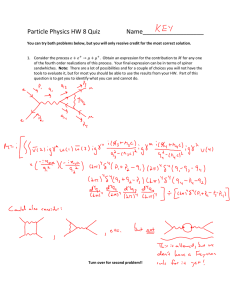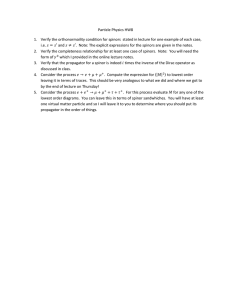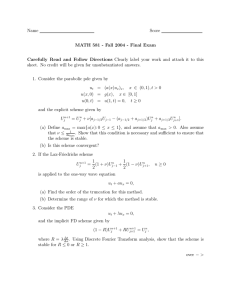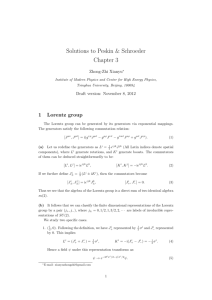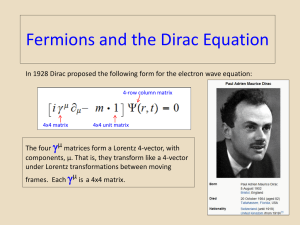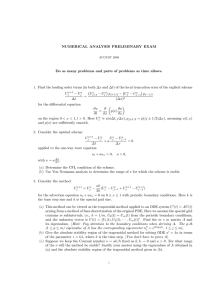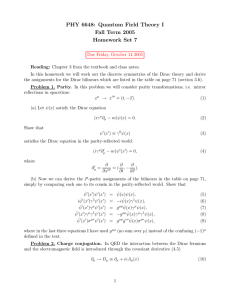Homework Assignment 6
advertisement
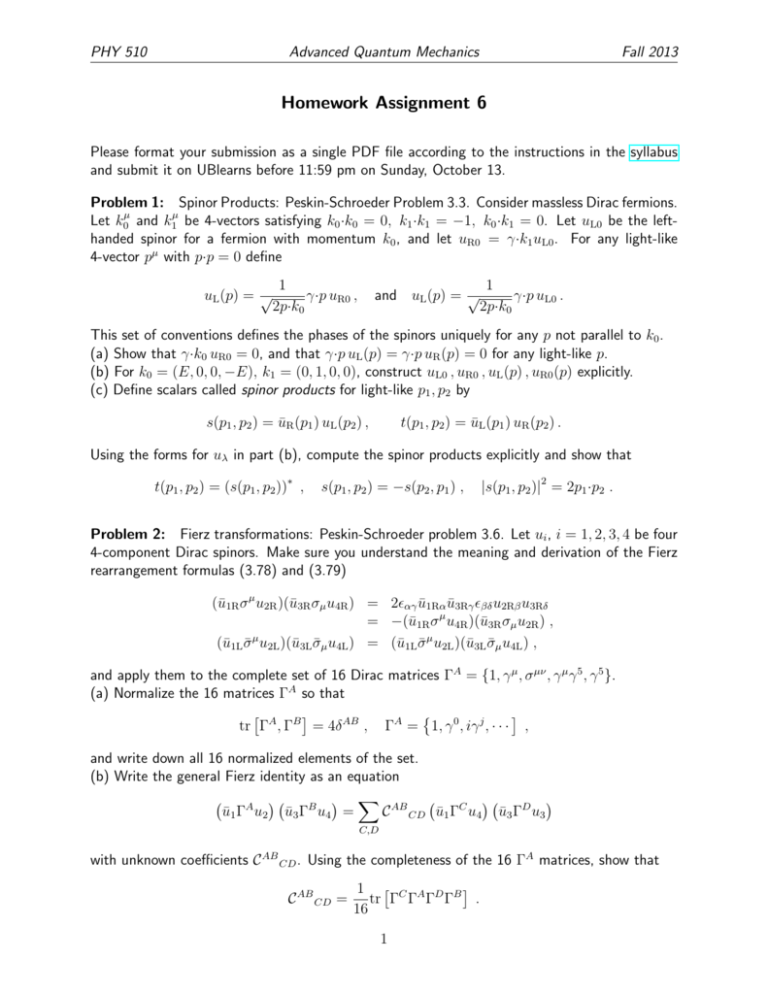
PHY 510
Advanced Quantum Mechanics
Fall 2013
Homework Assignment 6
Please format your submission as a single PDF file according to the instructions in the syllabus
and submit it on UBlearns before 11:59 pm on Sunday, October 13.
Problem 1: Spinor Products: Peskin-Schroeder Problem 3.3. Consider massless Dirac fermions.
Let k0µ and k1µ be 4-vectors satisfying k0 ·k0 = 0, k1 ·k1 = −1, k0 ·k1 = 0. Let uL0 be the lefthanded spinor for a fermion with momentum k0 , and let uR0 = γ·k1 uL0 . For any light-like
4-vector pµ with p·p = 0 define
uL (p) = √
1
and uL (p) = √
γ·p uL0 .
2p·k0
1
γ·p uR0 ,
2p·k0
This set of conventions defines the phases of the spinors uniquely for any p not parallel to k0 .
(a) Show that γ·k0 uR0 = 0, and that γ·p uL (p) = γ·p uR (p) = 0 for any light-like p.
(b) For k0 = (E, 0, 0, −E), k1 = (0, 1, 0, 0), construct uL0 , uR0 , uL (p) , uR0 (p) explicitly.
(c) Define scalars called spinor products for light-like p1 , p2 by
s(p1 , p2 ) = ūR (p1 ) uL (p2 ) ,
t(p1 , p2 ) = ūL (p1 ) uR (p2 ) .
Using the forms for uλ in part (b), compute the spinor products explicitly and show that
t(p1 , p2 ) = (s(p1 , p2 ))∗ ,
s(p1 , p2 ) = −s(p2 , p1 ) ,
|s(p1 , p2 )|2 = 2p1 ·p2 .
Problem 2: Fierz transformations: Peskin-Schroeder problem 3.6. Let ui , i = 1, 2, 3, 4 be four
4-component Dirac spinors. Make sure you understand the meaning and derivation of the Fierz
rearrangement formulas (3.78) and (3.79)
(ū1R σ µ u2R )(ū3R σµ u4R ) = 2αγ ū1Rα ū3Rγ βδ u2Rβ u3Rδ
= −(ū1R σ µ u4R )(ū3R σµ u2R ) ,
(ū1L σ̄ µ u2L )(ū3L σ̄µ u4L ) = (ū1L σ̄ µ u2L )(ū3L σ̄µ u4L ) ,
and apply them to the complete set of 16 Dirac matrices ΓA = {1, γ µ , σ µν , γ µ γ 5 , γ 5 }.
(a) Normalize the 16 matrices ΓA so that
tr ΓA , ΓB = 4δ AB , ΓA = 1, γ 0 , iγ j , · · · ,
and write down all 16 normalized elements of the set.
(b) Write the general Fierz identity as an equation
X AB
ū1 ΓA u2 ū3 ΓB u4 =
C CD ū1 ΓC u4 ū3 ΓD u3
C,D
with unknown coefficients C AB CD . Using the completeness of the 16 ΓA matrices, show that
C AB CD =
1 C A D B
tr Γ Γ Γ Γ .
16
1
PHY 510
Advanced Quantum Mechanics
Fall 2013
(c) Work out the Fierz transformation laws for the products (ū1 u2 )(ū3 u4 ) and (ū1 γ µ u2 )(ū3 γµ u4 ).
Problem 3: P, C, and T symmetries: Peskin-Schroeder problem 3.7.
(a) Compute the transformation properties under P , C, and T of the antisymmetric tensor
fermion bilinears ψ̄σ µν ψ, where σ µν = 2i [γ µ , γ ν ] to complete the table on page 71.
(b) Let φ(x) be a complex-valued Klein-Gordon field with Lagrangian density L = (∂µ φ)∗ (∂ µ φ) −
m2 φ∗ φ. Find unitary operators P , C, and an antiunitary operator T (all defined in terms of their
action on the annihilation operators ap and bp for Klein-Gordon particles and antiparticles) that
give the following transformations of the Klein-Gordon field:
P φ(t, x)P = φ(t, −x)
T φ(t, x)T = φ(−t, x)
Cφ(t, x)C = φ∗ (t, x)
Find the transformation properties of the current J µ = i [φ∗ ∂ µ φ − (∂ µ φ)∗ φ] under P , C, and T .
(c) Show that any Hermitian Lorentz-scalar local operator built from ψ(x), φ(x), and their
conjugates has CP T = +1.
Problem 4: Semiclassical spin waves: Altland-Simons Chapter 2 page 85.
(a) Making use of the spin commutation relation,
i
h
Ŝjα , Ŝkβ = iδjk αβγ Ŝiγ ,
apply the operator identity
h
i
iŜj = Ŝj , Ĥ
to express the equation of motion of a spin in a nearest neighbor spin-S one-dimensional Heisenberg ferromagnet as a difference equation.
(b) Interpreting the spins as classical vectors, and taking the continuum limit, show that the
equation of motion of the hydrodynamic modes takes the form
∂ 2S
∂S
=JS× 2 ,
∂t
∂x
where unit lattice spacing has been assumed. Find and sketch a wave-like solution describing
small angle precession around a globally magnetized state Sj = Sez .
Problem 5: Dirac Electrons in Graphene.
(a) Read Altland-Simons pages 55-57 and use Mathematica to make the surface and contour
plots shown in Fig. 2.3. Explain in words why this implies a Dirac equation.
(b) Download and read the article by M. Ezawa Phys. Lett. A 372, 924–929 (2008). Starting
from Eqns. (18,19) on page 926
1
0 A†
0 A
τ
τ
HP = {Qτ , Qτ } , [HP , Qτ ] = 0 , Q+ =
, Q− =
,
A 0
A† 0
2
derive the spectrum shown in Fig. 2 (a) on page 927 of the article.
2
